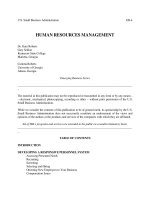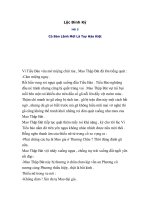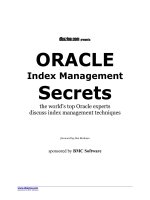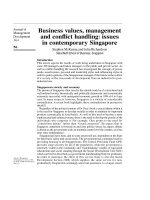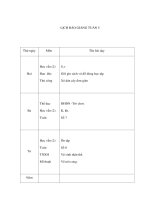Tài liệu E-Human Resource Management 5 ppt
Bạn đang xem bản rút gọn của tài liệu. Xem và tải ngay bản đầy đủ của tài liệu tại đây (685.22 KB, 9 trang )
22 Paauwe, Farndale, & Williams
Copyright © 2005, Idea Group Inc. Copying or distributing in print or electronic forms without written
permission of Idea Group Inc. is prohibited.
Box 4. Four roles of HR in the knowledge economy (Lengnick-Hall &
Lengnick-Hall, 2002)
Human Capital Steward
HR can act as a facilitator in partnership with employees with the aim of achieving the highest return
possible on the company’s human capital investments. Human capital goes beyond task-related
knowledge, skills, and abilities to include general life experiences, social skills, values, beliefs, and
attitudes. As such, individuals need to be guided and facilitated rather than controlled and dominated
.
The HR department needs to lose the policing or paternalistic role to encourage individual voluntary
contribution. Given human capital’s value to the organization, and that it is both unique and perishable
,
appropriate strategies for hiring, training, retaining, and removing need to be adopted, including the
encouragement of innovation and flexibility.
Knowledge Facilitator
The HR department has a role to play in facilitating both knowledge capital (held in explicit and
implicit sources) and knowledge flows. This can be achieved by promoting an understanding and value
of knowledge management, creating knowledge sharing and usage expectations. Other strategies
include schemes for continuous learning and brokering knowledge exchange. An overhaul of existing
appraisal and compensation practices may be required to support the desired knowledge managemen
t
behaviors. Furthermore, the HR department needs to encourage the organization to change its behavio
r
in light of what it learns.
Relationship Builder
The focus here lies on managing relationships between individuals and groups both internal and
external to the organization to enhance social capital across the total value chain. However
,
relationships are complex, requiring multiple dimensions to be considered, including: rapport (trust
,
respect, empathy), bonding (collaboration), breadth (scope, range of transactions), and affinity (interest
,
attraction). Appropriate HRM strategies for building such relationships include cross-functiona
l
teamwork, intra- and inter-organizational communication, inter-unit resource exchange, and inter-firm
learning.
Rapid Deployment Specialist
As firm competitiveness is increasingly dependent on speed, the HR department needs to take
responsibility for the development of flexible human capital resources with an emphasis on
adaptability, tolerance, and capacity to learn. This means creating human capital configurations that can
rapidly be assembled, deployed, and disassembled to meet the needs of fluid work assignments. Thi
s
entails the encouragement of appropriate employee attitudes, team behavior, and values that suppor
t
flexibility, adaptability, and creativity. Employees must be encouraged to self-organize, and be capable
of working in situations of crisis, stress, and uncertainty. A culture of widespread sharing o
f
organizational information and team-working is essential to achieve these aims.
Web-Based Organizing in Traditional Brick-and-Mortar Companies 23
Copyright © 2005, Idea Group Inc. Copying or distributing in print or electronic forms without written
permission of Idea Group Inc. is prohibited.
important, not just from a business point of view, but also from a human
resource development perspective. So what are the implications for HR
professionals of this revolutionary change process?
Implications for the HR Department
A major implication for the HR function in a business model redefinition
situation is probably the sea of change of the department’s own function.
Traditionally, the HR function has focused on delivering almost perfect quality
HR systems and services to the organization (Wright & Dyer, 2000). To do so
has required that they spend considerable amounts of time gathering and
analyzing information, garnering political support, and soliciting input from
multiple sources at each stage in the development process.
To reach such perfection takes a long time and a great deal of labor. It is hardly
surprising therefore that Wright and colleagues (1999) found that the design
and implementation of HR systems takes on average between 18 and 20
months. Given the rapid pace of the almost permanent change involved in any
organization revolution situation, firms can no longer afford to wait this long, nor
to pay the cost of such an elaborate development and implementation process.
HR has to deliver solutions as close to real time as possible, otherwise the firm
risks losing its advantage to competitors that are more agile. The outcome is a
focus on simpler but satisfactory rather than comprehensive and optimal HR
solutions (Wright & Dyer, 2000) — a significant change in culture.
Perhaps it is in this revolutionary situation that we can thus best start to see how
Web organizing is impacting on the function of HR as a whole. Lengnick-Hall
and Lengnick-Hall (2002) introduce four new roles for HR based on what they
describe as the knowledge economy in which many organizations are now
working: (a) human capital steward, (b) knowledge facilitator, (c) relationship
builder, and (d) rapid deployment specialist (see Box 4).
Parallels can easily be drawn between the new economy that Lengnick-Hall
and Lengnick-Hall (2002) describe and the Web-organized structures of
brick-and-mortar companies that this chapter has explored. Lengnick-Hall and
Lengnick-Hall’s roles are all elements of the HR role and HRM practices
discussed so far in this chapter as part of company responses to the Internet
economy. These responses and implications are now summarized in the
following section, drawing out the broader implications of Web organizing in
brick-and-mortar companies.
24 Paauwe, Farndale, & Williams
Copyright © 2005, Idea Group Inc. Copying or distributing in print or electronic forms without written
permission of Idea Group Inc. is prohibited.
Conclusions
In this brief overview, we have suggested that there are three main ways in
which old-economy companies are attempting to integrate the new economy as
extensions of their current businesses. These business models are summarized
in turn below, considering the implications for HRM practices and the HR
department. It is emphasized here that this is a new and interesting field in the
HRM literature that has not yet been fully explored empirically. We encourage
others to take up the challenge in this dynamic world to explore further the
tentative conclusions we are reaching here.
The first e-business model treats the Internet as an extension of the normal
marketplace. Companies use it primarily to sell more products or services and
to buy cheaper. This will involve many organizations operating primarily
through business-to-business exchanges. The transparency and global reach of
these exchanges will put major pressure on suppliers’ costs and speed and
flexibility of response.
We have suggested that the major accepted way for Western companies to
achieve necessary cost savings and performance increases is to adopt an agile
management approach combined with a flexible, high performance organiza-
tion to gain the maximum advantage from the globalization of the economy. This
implies a clear human capital steward role for the HR function to be highly
cost-efficient in the way in which it operates. In addition to broadening their
portfolio of expertise to cover the implementation of flexible working practices,
high performance work systems, and international HRM practices, HR profes-
sionals need to rethink how they deliver their service to their clients. E-HRM
has been discussed here as a tool for streamlining and improving the scope and
depth of service delivery, hence delivering the required cost savings and quality
improvements demanded of the department.
The second way in which old-economy companies are attempting to integrate
the new economy is by using the Internet to expand and improve collaborative
relationships among their key suppliers. We envisage many business-to-
business suppliers becoming members of fully integrated virtual supply chains,
with a need to develop trusting relationships between all partners in the
network, combined with the necessity of constant improvement in performance
and innovation.
In such a situation, what is needed is a combination of the rationality and order
of high performance work systems along with a willingness to constantly
Web-Based Organizing in Traditional Brick-and-Mortar Companies 25
Copyright © 2005, Idea Group Inc. Copying or distributing in print or electronic forms without written
permission of Idea Group Inc. is prohibited.
consider change and, where necessary, to implement innovation quickly. This
balance between strong routines on the one hand, and the freedom to
experiment and innovate on the other, is difficult for any organization to achieve.
It requires the development and maintenance of a climate of trust both internally
in the firm and externally between network partners. In addition, learning both
at individual and at organizational levels will have to be of a high order in order
to facilitate the necessary continuous improvement and innovation.
So again the role of the HR department is clear. Not only must they ensure
development and maintenance of a high performing, flexible organization, but
they must also assist in the development of trusting relationships and learning
and innovation. This involves a re-evaluation of the employer-employee
relationship that the company advocates, monitoring employee attitudes and
encouraging and rewarding participation, knowledge sharing, and risk taking to
the benefit of the company. The focus is on the relationship builder and
knowledge facilitator roles of HR professionals in developing a climate of
trust, innovation, and learning.
Finally, as we have suggested, there is also a third way that may be a temporary
state, but is much more fundamental. This approach requires old-economy
organizations to rethink totally their business models before deciding on their
e-commerce strategy. They must re-examine why customers buy from them,
look at all stages in the processes involved, and consider how the Internet could
impact each stage in the processes, and then, if necessary, develop new
business models for the required reorganization.
Here, the rapid deployment specialist role for HR is clear, alongside the
knowledge facilitator role. HR professionals must assist in managing the
multiple change processes involved and also help those involved in the process
to gather whatever learning is available as effectively as possible. And satisfying
rather than striving for perfection in daily operations will be the order of the day.
As our overview has pointed out, the uncertainties, problems, and complexities
for many organizations of moving business-to-business transactions onto the
Internet will mean that the pace for many will be slow even if it is steady. To start
with, both Internet-based and non-Internet-based systems are likely to be kept
running in parallel. For example, business-to-business selling in many compa-
nies will exist side-by-side with a more traditional approach. Selling through the
Internet may have major cost advantages, but it does not give much opportunity
for developing personal contacts, nor for the flexibility sometimes needed to
clinch the sale. For example, it is hard to enquire about a customer’s family
26 Paauwe, Farndale, & Williams
Copyright © 2005, Idea Group Inc. Copying or distributing in print or electronic forms without written
permission of Idea Group Inc. is prohibited.
during an ordering process on the Internet. Moreover, the Internet is often
inflexible in quoting a delivery date, whereas a good salesman knows how to
twist the system so that the customer gets the goods within his desired
timeframe. And so the HR function will also have to move in the directions we
have suggested, while at the same time continuing to fulfill its more traditional
roles.
Final Remarks
Web-based organizing is a complex issue. Few companies can easily be slotted
into the three models we have just described. Sub-units of many companies
may well be spread across different models, and some may be moving from one
model to another. The speed of change will also vary across business sectors.
In addition, there are many and varied problems alongside HRM issues
involved in the transfer of business-to-business transactions onto the Internet
that we have not discussed here. The move does however appear to be
inevitable. There is, therefore, a need to act quickly in order to be ready.
HRM is arguably becoming more important in this changing economy: the
relative unique value of fixed assets such as property and factories is declining,
while the unique value ascribed to intangible assets is increasing. Intangible
assets involve people: people’s ideas, people’s contacts, people’s ability to
manage in the midst of chaos, people’s vision and experience, people’s intuition
or understanding of markets, and so on. However, people are free agents; they
can, and do, change employers frequently. Therefore, HRM should concen-
trate on the systems that underpin people’s successful behavior, that is to say
the systems that stimulate and support the new desired behaviors we have been
discussing. These systems are what HR managers need to identify as appropri-
ate for their own company, so that they can then guide management in adapting
and improving these systems to realize organizational potential. These internal
improvements, necessary for successful transference of business to the Internet,
may at last enable the HR function to justify its existence in financial terms.
A fitting end to this chapter is perhaps provided by Braunschvig’s (1998, p.
178) conclusion that both American and especially European old-economy
firms must leverage their human and technological resources simultaneously to
achieve higher productivity growth:
Web-Based Organizing in Traditional Brick-and-Mortar Companies 27
Copyright © 2005, Idea Group Inc. Copying or distributing in print or electronic forms without written
permission of Idea Group Inc. is prohibited.
“This could well be the opportunity of last resort for mature economies
challenged by companies from younger, hungrier cultures and countries.”
References
Atkinson, J., & Meager, N. (1986). Changing working patterns: How
companies achieve flexibility. London: NEDO.
Balogun, J., & Hope-Hailey, V. (2004). Exploring strategic change. Harlow:
FT/Prentice-Hall.
Baumard, P. (1999). Tacit knowledge in organizations. Thousand Oaks,
CA: Sage Publications.
Blois, K. (1999). Trust in business-to-business relationships: An evaluation of
its status. Journal of Management Studies, 36(2), 197-215.
Boselie, P., & Dietz, G. (2003). Commonalities and contradictions in research
on human resource management and performance. Paper presented at the
Academy of Management Meeting, Seattle, Washington, August.
Bovet, D., & Martha, J. (2000). Value nets. New York: John Wiley & Sons.
Braunschvig, D. (1998). Work remade. In D. Leebaert (Ed.), The future of
the electronic marketplace. Boston, MA: MIT Press.
Brewster, C., Communal, C., Farndale, E., Hegewisch, A., Johnson, G., &
Van Ommeren, J. (2001). The HR Healthcheck. Benchmarking HRM
practice across the UK and Europe. London: Financial Times/Prentice-
Hall.
Bunnell, C. (2000). Making the Cisco connection. New York: John Wiley &
Sons.
Child, J., & Faulkner, D. (1998). Strategies of cooperation, managing
alliances, networks and joint ventures. Oxford: Oxford University
Press.
Cohen, W.M., & Levinthal, D.A. (1990). Absorptive capacity: A new per-
spective on learning and innovation. Administrative Science Quarterly,
35(1), 128-152.
Cool, K. (1997). The competitiveness of European industry. Inauguration
address for the BP Chair in European Competitiveness, INSEAD, June 3.
28 Paauwe, Farndale, & Williams
Copyright © 2005, Idea Group Inc. Copying or distributing in print or electronic forms without written
permission of Idea Group Inc. is prohibited.
Cusumano, M.A. (1994). The limits of lean. Sloan Management Review,
35(4), 27-32.
Evans, P.B., & Wurster, T.S. (1997). Strategy and the new economics of
information. Harvard Business Review, 75(5), 71-83.
Floyd, P. (2002). Organizational change. Oxford: Capstone.
Fujimoto, T. (1999). The evolution of a manufacturing system at Toyota.
New York: Oxford University Press.
Greenspan, A. (2000). Global economic integration: Opportunities and chal-
lenges. Retrieved from www.federalreserve.gov (symposium speech,
August 25).
Grimshaw, D., Breu, K., & Myers, A. (2002). Releasing the value of
knowledge: A Cranfield School of Management and Microsoft sur-
vey of UK industry. London: Financial Times/Prentice-Hall.
Handy, C. (1995). Trust and the virtual organization. Harvard Business
Review, 73(3), 40-50.
Hansen, M.T., & Deimler, M.S. (2001). Cutting costs while improving morale
with B2E management. Sloan Management Review, 43(1), 96-100.
Harris, H., Brewster, C., & Sparrow, P. (2003). International human
resource management. London: CIPD.
Hartman, A., & Sifonis, J. (2000). Net ready. New York: McGraw Hill.
Lengnick-Hall, M.L., & Lengnick-Hall, C.A. (2002). Human resource man-
agement in the knowledge economy: New challenges, new roles, new
capabilities. San Francisco, CA: Berrett-Koehler.
McAllister, D.J. (1995). Affect and cognition-based trust as foundations for
interpersonal cooperation in organizations. Academy of Management
Journal, 38(1), 24-59.
McCall, M.W. (1988). Developing executives through work experiences.
Human Resource Planning, 2(1), 1-12.
McCurry, L., & McIvor, R. (2002). Agile manufacturing: 21st century strategy
for manufacturing on the periphery? Irish Journal of Management,
23(2), 75-93.
Nooteboom, B. (1996). Trust, opportunism and governance: A process and
control model. Organizational Studies, 17(6), 985-1010.
Web-Based Organizing in Traditional Brick-and-Mortar Companies 29
Copyright © 2005, Idea Group Inc. Copying or distributing in print or electronic forms without written
permission of Idea Group Inc. is prohibited.
Nooteboom, B. (2000). Trust as a governance device. In M. Casson & A.
Godley (Eds.), Cultural factors in economic growth (Chapter 1).
Berlin: Springer-Verlag.
Paauwe, J. (2004). Changing HRM roles: Towards a real balanced HRM
scorecard. In J. Paauwe (Ed.), HRM and performance: Unique ap-
proaches for achieving long-term viability (Chapter 9, pp. 217-251).
Oxford: Oxford University Press.
Rayport, J.F., & Sviolka, J.J. (1995). Exploiting the virtual value chain.
Harvard Business Review, 73(6), 75-85.
Ruël, H., Bondarouk, T., & Looise, J.K. (2003). E-HRM, innovation or
irritation? An exploration of Web-based human resource management in
large companies. Paper presented at the 7th Conference on Interna-
tional Human Resource Management, University of Limerick, Ireland,
June.
Schwartz, E. (1997). Webonomics. New York: Broadway Books.
Seely Brown, J., & Duguid, P. (2000). The social life of information.
Boston, MA: Harvard Business School.
Shapiro, C., & Varian, H.R. (1999). Information rules. Boston, MA:
Harvard Business School Press.
Sharp, J.M., Irani, Z., & Desai, S. (1999). Working towards agile manufac-
turing in the UK industry. International Journal of Production Eco-
nomics, 62(1/2), 155-69.
Shockley-Zalabak, P., Ellis, K., & Winograd, G. (2000). Organizational trust:
What it means, why it matters. Organization Development Journal,
18(4), 35-48.
Siebel, T. (2001). How Siebel systems found its groove. Retrieved December
19, 2001, from knowledge.wharton.upenn.edu/
Stabell, C.B., & Fjeldstad, O.J. (1998). Configuring value for competitive
advantage: On chains, shops, and networks. Strategic Management
Journal, 19(5), 420-431.
Tapscott, D. (1999). Creating value in the network economy. Boston, MA:
Harvard Business School Press.
Tapscott, D., Ticoll, D., & Lowy, A. (2000). Digital capital. London:
Brealey.
Timmers, P. (1999). Electronic commerce. New York: John Wiley & Sons.
30 Paauwe, Farndale, & Williams
Copyright © 2005, Idea Group Inc. Copying or distributing in print or electronic forms without written
permission of Idea Group Inc. is prohibited.
Ulrich, D. (1997). Human resource champions. Cambridge, MA: Harvard
Business School Press.
Useem, J., & Watson, N. (2001). It’s all yours Jeff. Now what? Fortune,
144(5), 64-68.
Van Alstyne, M. (1997). The state of network organization: A survey in three
frameworks. Journal of Organizational Computing, 7(2/3), 83-151.
Van den Bos, M., & Methorst, W. (2004). E-HRM: HRM ondersteund door
ICT. In J. Paauwe & J. Van Breukelen (Eds.), Personeelsmanagement
in bedrijf: Een bijdrage aan het beter presteren van individu en
organisatie. Alphen a/d Rijn: Kluwer.
Venkatraman, N. (2000). Five steps to a dot-com strategy: How to find your
footing on the Web. Sloan Management Review, 41(3), 15-28.
Whitener, E.M. (1997). The impact of human resource activities on employee
trust. Human Resource Management Review, 7(4), 389-404.
Wood, S. (1999). Human resource management and performance. Interna-
tional Journal of Management Reviews, 1(4), 367-414.
Wright, P.M., & Dyer, L. (2000). People in the e-business. New challenges
and new solutions. Working Paper 00-11, Center for Advanced Human
Resource Studies, Cornell University, Ithaca, New York.
Wright, P.M., Dyer, L., & Takla, M. (1999). Execution: The critical what’s
next in strategic human resource management. The 1999 Human
Resource Planning Society State of the Art and Practice Council
report. New York: Human Resource Planning Society.
Wyckoff, A. (1997). Imagine the impact of electronic commerce. The OECD
Observer, 208(October-November).
